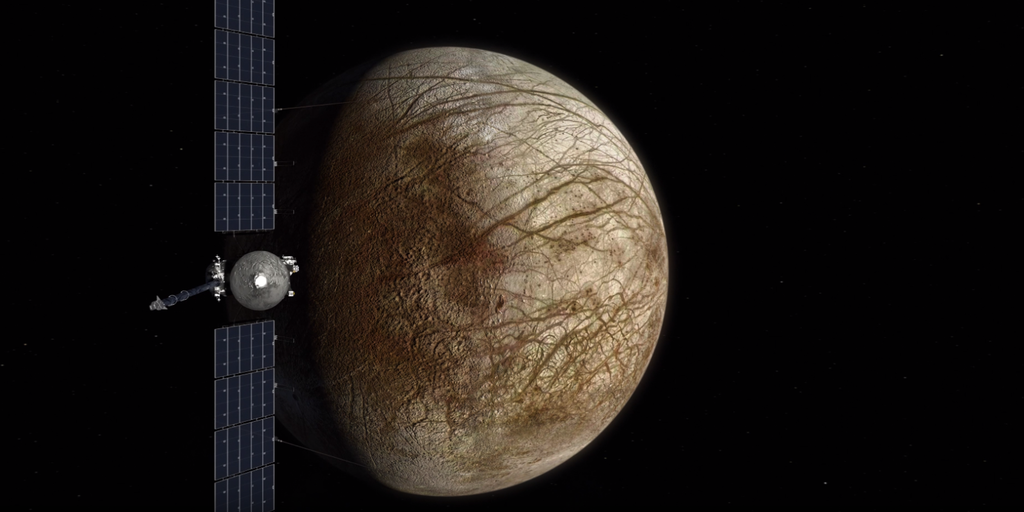The Europa Clipper: A Mission to Explore Jupiter’s Moon
The Europa Clipper is embarking on a groundbreaking five-year mission to explore Europa, one of Jupiter’s moons. Recently, NASA and the Jet Propulsion Laboratory (JPL) invited media outlets, including Decrypt, to gain an up-close look at this pioneering spacecraft.
The Clipper Mission
Scheduled to launch in October, the Europa Clipper aims to conduct flybys around Jupiter to study Europa in great detail. Its mission is to document the moon, evaluate its potential habitability, analyze its surface and subsurface ocean, search for signs of life, and study its composition and geology.
The spacecraft will provide invaluable insights into one of the most intriguing celestial bodies in our solar system.
Behind the Scenes: Exploring the Europa Clipper
The media day commenced at the NASA/JPL visitor center, where attendees were briefed on security protocols before proceeding to witness the Europa Clipper up close.
Entering the spacecraft assembly facility, participants underwent a meticulous cleaning process to ensure no contaminants entered the sterile environment. Equipped with gowns and protective gear, visitors witnessed the massive scale of the Europa Clipper housing area.
Engineers emphasized the spacecraft’s robustness, subjecting it to rigorous testing procedures to simulate launch conditions and ensure its resilience during the mission.
Engineering Marvels of the Europa Clipper
Europa Clipper Project Manager Jordan Evans shed light on the spacecraft’s intricate design, optimized to accommodate various scientific instruments and operational requirements. The spacecraft’s shape and functionality are meticulously calibrated to maximize data collection efficiency.
One of the standout features of the Europa Clipper is its high gain antenna, crucial for transmitting collected data back to Earth through the Deep Space Network, a marvel of interplanetary communication technology.
The Role of AI in Space Exploration
While artificial intelligence has revolutionized many aspects of space exploration, the Europa Clipper mission relies on traditional computing systems for its operations. According to Tracy Drain, a Flight Systems Engineer, the spacecraft’s onboard software is meticulously programmed to execute its mission objectives seamlessly.
At a time when AI is gaining prominence in scientific endeavors, the Europa Clipper stands as a testament to human ingenuity and technological prowess.
A Legacy of Exploration: JPL Through the Ages
Jet Propulsion Laboratory (JPL), founded in 1943, has a rich history rooted in pioneering space exploration achievements. From its humble beginnings as a collaborative effort by Caltech students and enthusiasts, JPL has evolved into a hub of innovative scientific research and discovery.
The von Kármán auditorium, adorned with tributes to past missions like Voyager and Cassini, showcases JPL’s enduring legacy of pushing the boundaries of human knowledge.
Unveiling Europa’s Mysteries
JPL Deputy Project Scientist Bonnie Buratti highlighted the Europa Clipper’s primary objective of seeking environments conducive to life rather than immediate life detection. She emphasized the challenges posed by Europa’s unique surface features and the need for caution in navigating this enigmatic moon.
The potential discovery of life-supporting ecosystems on Europa would serve as a catalyst for further exploration and scientific inquiry, underlining the mission’s significance in unraveling the mysteries of our universe.
Exploring the Beyond: Opportunities at JPL
Reflecting on the visit to JPL, attendees were inspired by the institution’s commitment to pushing the boundaries of space exploration. Tracy Drain encouraged aspiring scientists and space enthusiasts of all backgrounds to consider a career at JPL, emphasizing the diverse range of skill sets required to contribute meaningfully to space-related endeavors.
From engineering to journalism, JPL offers a multitude of pathways for individuals passionate about unlocking the secrets of the cosmos.
Image/Photo credit: source url





